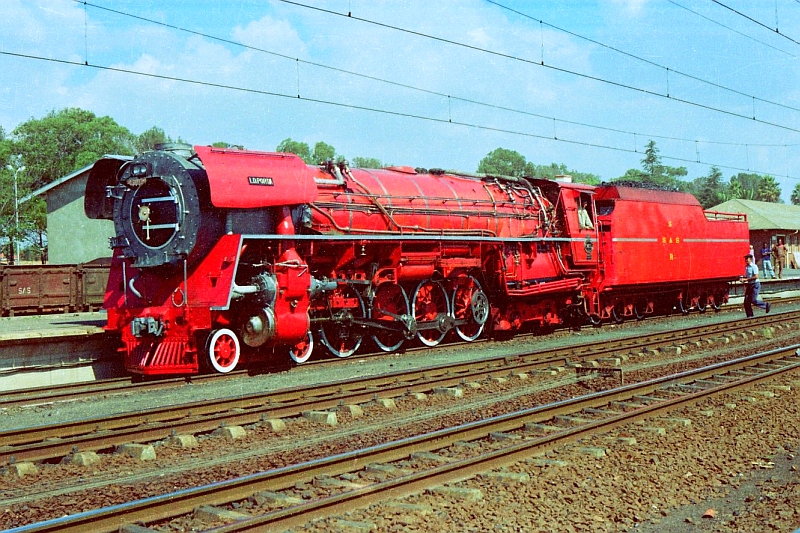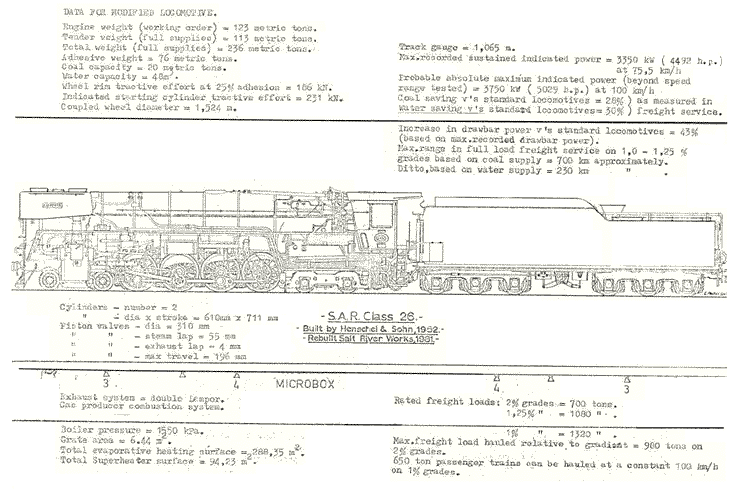| Better known as "The Red
Devil" because of its bright
paint job, this 4-8-4 showed
that 1950's steam had by no mean
reached the limits of
performance. It was developed
from an existing class 25NC
4-8-4 by David Wardale of
England along the principles
advocated by L. D. Porta.
Wardale came to work in South
Africa in 1974 and was given a
minor position in the Chief
Mechanical Engineer's office
with the South African
Railways (SAR). As a steam
enthusiast, he sincerely
believed that South Africa was
making a serious mistake by
scrapping their steam fleet
even as fuel oil prices were
increasing and availability
was becoming shaky. From his
lowly post, Wardale repeatedly
made suggestions to his
superiors that steam
improvements should be
considered, evidently to no
effect. Finally, under the
pretense of reducing its
tendency to start line-side
fires, he was allowed to make
modifications to a Class 19D
4-8-2. Wardale knew that the
GPCS could accomplish this,
while greatly increasing the
power and economy of the
locomotive.
Working by himself at SAR,
with some long-distance
assistance from Porta, Wardale
undertook to modify 19D no.
2644. Modifications were
limited because they had to be
fabricated and installed at a
running shed, which had
limited time and resources. A
GPCS and dual Lempor exhaust
were installed on the engine,
along with some other small
improvements. As this was
Wardale's first attempt at
modernizing a steam
locomotive, there were
understandably a few
"teething" troubles that had
to be overcome. Nevertheless,
after a few weeks of "tuning
up" and minor modifications,
the locomotive proved capable
of significantly higher power
and significantly lower fuel
consumption than other 19D's.
Several "official" names were
given to the locomotive, but
the crews had their own name
for it: "Spooky". This was
partially in reference to its
quieter exhaust and partially
in reference to its unearthly
performance. With some solid
proof to back up his claims to
his superiors of steam's
untapped potential, he
eventually was allowed to make
more-extensive modifications
on a bigger locomotive.
![[SAR Class 26]](pics/3450%20L%20D%20Porta.jpg)
South
African Railways Class 26 No.
3450 "L. D. Porta"
photo
copyright 2008 Martyn
Hearson, used with
permission
Wardale started with an SAR
Class 25NC 4-8-4 locomotive,
no. 3450. The 25NC's (and
their condensing brothers, the
25C's) were generally
considered the most modern
steam locomotives operating in
South Africa, and on par with
the most modern steam
locomotives ever built. They
were equipped with large
boilers, cast bed engine
frames, roller bearings on all
axles and rods, and extensive
mechanical lubrication. The
25NC's were basically modern
U.S. 4-8-4's scaled down from
4 foot 8-1/2 inch gauge to the
South African 3 foot 6 inch
gauge. Their only deficiencies
compared to U.S. steam were
relatively low boiler pressure
(225 PSIG) and the lack of a
feedwater heater. By improving
what was already considered to
be an advanced steam design,
Wardale hoped to prove that
there was a great deal of
untapped potential in even the
most modern steamer.
Doing most of the design work
himself, with some minor
assistance from a couple of
other engineers, Wardale
designed more-extensive
improvements for this engine.
The Red Devil was equipped
with the GPCS, improved piston
valves, enlarged superheater
and steam chests, double
Lempor exhaust, a feedwater
heater, and other
improvements. While the
improvements sound extensive,
they were greatly limited by
the existing structure of the
locomotive and the time and
money allocated. Boiler
pressure could not be raised,
only minor changes to the
steam chests could be
accomodated, and parts had to
be adapted from other existing
locomotives (such as the
superheater header from a GMAM
Garratt).

No. 3450 in
original form 1983/1984
photo by Hannes Paling, used
with permission
Once again, after a trying
period of fine-tuning, the Red
Devil began to show hints of
the true performance potential
of steam. In service, the 3450
showed over a 38% reduction in
fuel costs per ton-mile
compared to the standard
25NC's. Sustained drawbar
horsepower readings of over
4000 HP were attained in
testing (significantly more
than developed by the MUCH
larger C & O 614 while
burning much better coal in
later testing), thought to be
the world record for a narrow
gauge steam locomotive. Roger
Waller (later of the Swiss
Locomotive Works) came to
South Africa about this time
and assisted with testing of
the locomotive.

Image courtesy
Martyn Bane
Despite the outstanding
performance of no. 3450,
however, the South African
railways proceeded with the
quick retirement of their
steam fleet. "Management" had
already decided that steam
must go and any opinions (or
scientic proof for that
matter) to the contrary were
barely tolerated. Even as the
tests of no. 3450 were being
conducted, it was obvious that
steam was in decline. Great
difficulty was caused by poor
workmanship on some repairs
and by the decreasing quality
of coal. The momentum of 35
years of stagnation in steam
locomotive development was too
much for Wardale to overcome.
When it became clear that no
duplicates of no. 3450 would
be constructed, Wardale left
South Africa to pursue other
opportunities, and was soon
contacted by some crazy
Americans with some ideas for
coal-burning locomotives. See
the ACE
page for details.
In recent years, steam in
South Africa has been
relegated to a few industrial
lines and special
events. The Red Devil
was unfortunately
significantly de-modernized as
steam maintenance standards
declined. Recently, 19D 2644,
Wardale's first project on the
SAR, was severely damaged by
theives who stole the bronze
driving axle bearings, and the
locomotive was scrapped as a
result. On a brighter
note, the Red Devil was
overhauled in 2018 and will be
used on passenger excursion
trains in the future and it is
hoped all of Wardale's
improvements can eventually be
refitted as time and finances
allow.
|